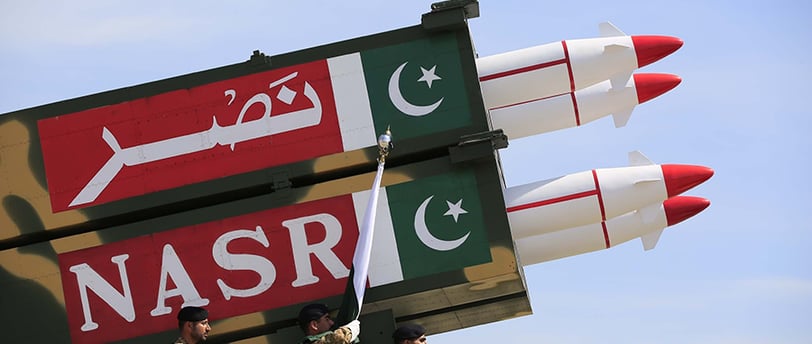Pakistan’s Nuclear Policy: Safeguarding Deterrence and Promoting Regional Stability
Pakistan’s nuclear policy stands at the heart of its national security framework, playing a major role in shaping South Asia’s broader strategic environment. As a nuclear-armed state operating outside the Nuclear Non-Proliferation Treaty (NPT) regime, Pakistan’s approach is centered on deterrence rather than aggressive expansion. Its key aim is to maintain regional power equilibrium, particularly given its historically turbulent relations with India.
Priya jassi, 3rd year, B.A., LL.B (hons.)
5/1/20252 min read


Historical Background
Pakistan’s drive toward nuclear capability gained serious momentum after the 1971 war, a conflict that not only led to the secession of Bangladesh but also deeply impacted Pakistan’s strategic thinking. This sense of urgency intensified after India conducted its first nuclear test in 1974, prompting Pakistan to accelerate its own nuclear development. A pivotal figure in this effort was Dr. Abdul Qadeer Khan, whose role was crucial in establishing Pakistan’s nuclear infrastructure and operational capabilities.
Key Pillars of Pakistan’s Nuclear Doctrine
1. Credible Minimum Deterrence
Pakistan’s nuclear posture avoids entering into an exhaustive arms race with India. Instead, it is focused on maintaining a credible minimum deterrent—sufficient to prevent aggression without the burden of matching India’s arsenal weapon-for-weapon.
2. First-Use Policy
Unlike India’s officially declared No First Use (NFU) stance, Pakistan retains the right to use nuclear weapons first if faced with a significant conventional military threat. This policy is designed to deter any major military actions by raising the risks for potential adversaries early in a conflict.
3. Full Spectrum Deterrence
Pakistan’s doctrine has evolved to address a wide array of potential conflict scenarios—from large-scale wars to smaller skirmishes. Full Spectrum Deterrence incorporates both long-range strategic nuclear arms and tactical nuclear weapons, ensuring that Pakistan’s nuclear umbrella can cover threats at every level of escalation.
Nuclear Command and Security Framework
Oversight of Pakistan’s nuclear arsenal is managed by the National Command Authority (NCA), which unites both civilian and military leadership to ensure responsible and coordinated control. In response to international concerns—especially following the exposure of the A.Q. Khan network—Pakistan has significantly strengthened its nuclear security infrastructure, enhanced its export control laws, and implemented strict measures to protect its nuclear assets from internal and external threats.
Global Views and Emerging Risks
Despite Pakistan’s strengthened nuclear security measures, international apprehensions persist. The development of tactical nuclear weapons, such as the Nasr missile, has led to concerns that the
threshold for nuclear use might be lowered, making crisis management more complex and increasing the risk of unintended escalation during times of tension.
India’s Impact on Pakistan’s Nuclear Strategy
Pakistan’s nuclear doctrine is heavily influenced by its enduring rivalry with India. Historical events like the Kargil conflict, the 2001 Indian Parliament attack, and the 2019 Pulwama-Balakot incident show how quickly tensions can spiral. While nuclear deterrence has so far prevented a full-scale war between the two countries, the persistent risk of accidental escalation remains a major worry.
Comparative Overview: India and Pakistan’s Nuclear Strategies
1. Strategic Doctrine:
India adheres to a declared NFU policy, while Pakistan maintains the flexibility of a first-use option.
2. Strategic Emphasis:
India’s nuclear policy emphasizes strategic deterrence, whereas Pakistan’s doctrine is designed to extend deterrence across both strategic and tactical domains.
3. Policy Priorities:
India’s nuclear outlook leans toward fostering long-term global stability and engagement, while Pakistan’s focus remains on immediate regional security concerns and rapid response capabilities.
While both nations share the view that nuclear deterrence is vital for regional peace, their approaches reflect different priorities—India favoring strategic restraint and Pakistan opting for a dynamic, regionally focused posture.
Conclusion
Pakistan’s nuclear strategy is driven by its pressing regional security concerns rather than a commitment to broader global disarmament initiatives. Given the unresolved tensions with India, Islamabad will likely continue emphasizing a credible deterrent posture. However, lasting peace in South Asia would greatly benefit from more transparency, robust crisis communication mechanisms, and sustained dialogue between the neighboring countries.
References:
Arms Control Association – Pakistan’s Evolving Nuclear Doctrine
Nuclear Threat Initiative – Pakistan
Regional Studies – India-Pakistan Nuclear Doctrines
Centre for Strategic and Contemporary Research – Pakistan’s Nuclear Journey
Because Every Legal Mind Deserves a Great Conversation.
Legaltea.in@gmail.com
+91 6284295492
MSME Certified
© 2025 Legal Tea. All rights reserved.


